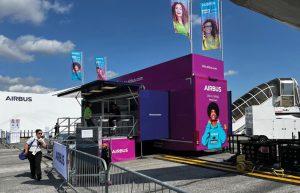BLOOMBERG
Airbus SE reigned supreme at the Paris Air show, kicking off with a mammoth 500-plane order from low-cost carrier Indigo. Now all it has to do is find enough workers to build them.
Lurking just beneath the spectacle of multi-billion dollar aircraft sales and aerial acrobatics on display outside the French capital is a shortage of parts and labour that threatens the aerospace industry’s ability to deliver on time to airlines hungry for more capacity.
From engine and semiconductor shortages to glitches with suppliers to disruptions caused by the war in Ukraine, Airbus and its US counterpart Boeing Co have had to dodge one calamity after another to stand up a global network of subcontractors laid low by the pandemic. While the crisis peaked last year, the frailty of the recovery was on display in Paris, where help-wanted signs were everywhere.
“Last year we missed the targets by very much,†Airbus Chief Executive Officer Guillaume Faury told analysts at a meeting in Paris. “This year we’ll deliver on performance.â€
At the heart of the challenge is a shortage of workers. Aerospace companies typically lay off employees in a downturn and then seek to hire them back, with a success rate of about 80%, according to Airbus procurement chief Jürgen Westermeier. During Covid-19, many workers gravitated towards other areas of manufacturing that weren’t as hard-hit as aerospace, or left the industry entirely. These days, Westermeier said, aerospace employers are lucky to rehire two out of 10.
This year alone, Airbus wants to bring in 13,000 new recruits globally. About halfway through the year, it’s filled 7,000 of those positions, in what the company called “a challenging labor market.†Boeing grew its staff by 15,000 people last year and has its sights on 10,000 hires in 2023.
“When you pull the thread through almost everything, it almost invariably ends with labor,†said Mike Kauffman, the supply chain chief at engine-maker GE Aerospace, in an investor event this week. “The ability to attract it, retain it, train it in time.â€
While Faury remains optimistic about this year’s goal of 720 aircraft deliveries, the company fell short last year, first lowering and then missing its reduced target. As of May, the company had fulfilled about one third of this year’s delivery target, suggesting the European planemaker faces yet another race to meet the deadline in December.
Last year’s setbacks sent shudders through the network of some 13,000 Airbus suppliers who provide 70% to 80% of parts by value in a typical airliner.
While some contractors couldn’t keep up last year — forcing Airbus to scale back its ambitions — others that had stretched to deploy capital suddenly found that they had over-ordered parts from their own suppliers.
Part of the purpose of Airbus’s presentation was to overcome any lingering doubts.
 The Gulf Time Newspaper One of the finest business newspapers in the UAE brought to you by our professional writers and editors.
The Gulf Time Newspaper One of the finest business newspapers in the UAE brought to you by our professional writers and editors.
